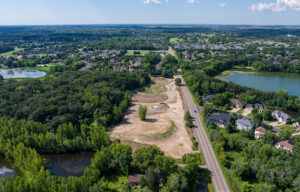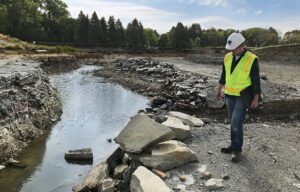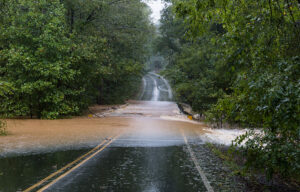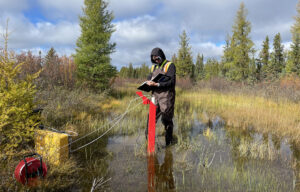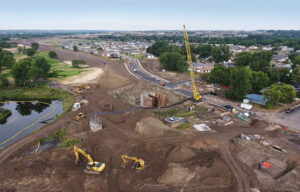Addressing water scarcity: A case study on aquifer storage and recovery projects

Water scarcity and groundwater depletion are areas of growing concern in the United States and around the world, and both are being exacerbated by climate change. Prolonged droughts are having a significant impact on agriculture, industry, and households across the U.S. These water shortages stress the growing need to improve effective water management strategies while also balancing the financial and environmental costs associated with different water management solutions.
ASR is a method that stores excess surface water in underground aquifers. The water is then recovered during times of drought or increased demand, providing a means of long-term natural water storage.
One innovative approach to address water scarcity concerns is through the implementation of aquifer storage and recovery (ASR) projects, which is a subset of managed aquifer recharge (MAR) projects. ASR is a method that stores excess surface water in underground aquifers. The water is then recovered during times of drought or increased demand, providing a means of long-term natural water storage. Compared with surface reservoirs, underground aquifers also prevent water loss through evaporation, provide greater protection from pollution or contamination sources, store larger volumes of water, and have fewer environmental impacts. The cost of an ASR program is typically considerably lower than constructing a large surface reservoir. Since stored water undergoes natural filtration while underground, it presents the added benefit of improving water quality.
ASR projects have been successfully deployed in several states and countries, bolstering water supply resilience by creating a buffer against drought-induced shortages. These projects demonstrate the potential of a sustainable groundwater management method to mitigate water shortages while also replenishing depleted groundwater.
What is involved with ASR projects?
ASR involves moving excess water during wet or snowy periods, or water that is available through underutilized water rights, underground for storage in local aquifers for later recovery. Depending on factors such as location, scale, and available resources, an ASR project scope typically includes the following elements:
-
Feasibility assessment: The suitability of the chosen aquifer is assessed based on factors like geologic and hydrogeologic characteristics, water quality, and legal, environmental, and regulatory considerations.
-
Source water supply: A source of excess water, often from surface water bodies like rivers, excess spring flow, snowmelt or precipitation runoff, underutilized water rights, imported water, or wastewater treatment plant effluent, is identified.
-
Infiltration/injection and recovery wells: There are two methods for moving water into an aquifer: infiltration or injection. Infiltration directs water to constructed basins or natural features, such as dry stream beds, that are known to be connected to the target aquifer. The injection method transfers water directly into the target aquifer via injection wells. Water stored in an aquifer can then be recovered in a future time of need via a dedicated recovery well or by pumping an injection well.
-
Water quality and treatment: Depending on the quality of the source water, the water may need to undergo treatment to meet water quality standards before injection or infiltration. Water chemistry also needs to be assessed on the source water to avoid adverse chemical reactions with the aquifer water or the aquifer material (i.e., sediments or rocks).
-
Monitoring and control systems: Monitoring and control systems are necessary to track water quality, pressure, and flow rates within the aquifer. These systems help make sure that stored water remains viable and can be safely recovered.
-
Regulatory approvals: To comply with environmental and water quality regulations, ASR projects require permits and regulatory approvals from local, state, and/or federal authorities.
-
Infrastructure: To transport, inject, and recover water, additional infrastructure may be needed. This might include pipelines, wells, pumps, and treatment facilities.
-
Testing and pilot programs: Before full-scale implementation, pilot programs are often conducted to evaluate the effectiveness of the ASR system and make necessary adjustments. Pilot programs also typically include chemical analyses of water and aquifer materials.
-
Community and stakeholder engagement: Engaging with local communities and stakeholders helps to address concerns and gain community support.
-
Operations and maintenance: Ongoing maintenance and monitoring are essential for the long-term success and sustainability of the project. This may include monitoring aquifer water levels, water quality, and infiltration or injection rates. These rates can change over time, requiring periodic cleaning of infiltration basins or redevelopment of wells to maintain infiltration or injection rates at an acceptable level.
-
Emergency response and contingency planning: Planning for unexpected water quality issues or system failures is critical to mitigate risks associated with ASR projects.
Since 2019, Barr has been working with the city of Provo, Utah, on an ASR project to help meet its anticipated increase in water demand due to the city’s growth. To better illustrate the steps involved in an ASR project, we’ve highlighted some of the key aspects below, using our work with Provo as a case study.
ASR case study: City of Provo, Utah
ASR feasibility study and site screening
Over the last decade, the city of Provo, Utah, has experienced rapid growth that is projected to continue over the next few decades. This rapid growth has resulted in increased water demand. To date, Provo’s water supply has come from mountain springs and groundwater pumped from the aquifer underlying the city. However, the pumping has resulted in the aquifer being over-appropriated, meaning more water has been pumped from the aquifer than added to it via natural recharge. The over-appropriation from increasing water demands and the impacts of climate change have led to declining aquifer groundwater levels over the last 40 years.
In 2019, Barr began working with Provo to perform an extensive ASR study. Together with the city and its water-rights attorney, we identified surface-water sources and infiltration and injection sites that were appropriate and consistent with the city’s 40-year water-supply plan.
For the initial screening of sites for ASR suitability, Barr developed a methodology to rank sites based on injection and infiltration potential and suitability. As part of our initial screening, we evaluated existing city wells for injection potential and made a preliminary estimate of infiltration capacity in an ephemeral mountain stream (i.e., a stream that carries water seasonally, or less often, so it is dry for extended periods). To help us rank sites for suitability and to better understand the nature of the geologic materials underlying the city of Provo, we leveraged data from the 2019 snowmelt event, conducted geophysical surveys at several sites, and made use of publicly available information from wells. As a result of our ranking methodology, five sites—three infiltration and two injection—were identified for pilot testing.
Pilot testing, modeling, and permitting
To help evaluate pilot testing at the sites, we installed monitoring well networks and collected data on infiltration or injection capacity. We also performed mineralogical analysis on unconsolidated geologic materials in the aquifer underlying the sites. Finally, Barr assessed geochemical interactions between the infiltrated/injected source water and the target aquifer at each site.
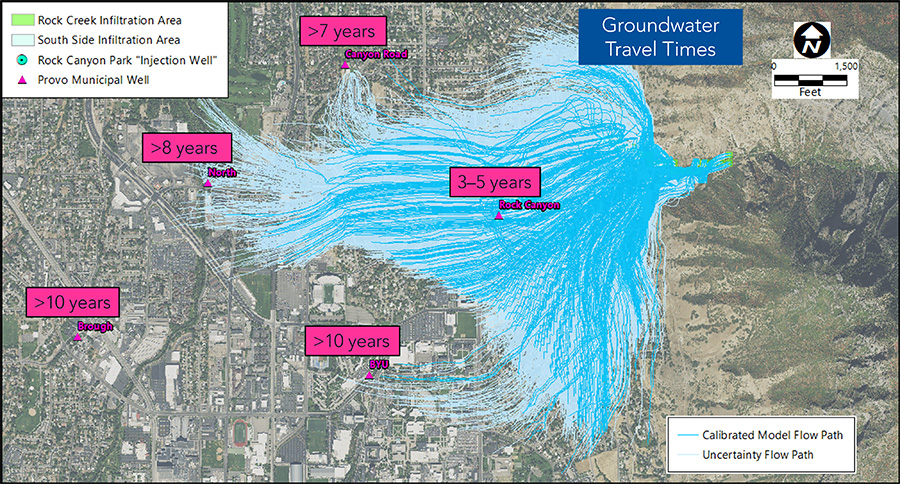
Barr completed pilot testing at two infiltration sites and two injection sites in 2022. Subsequently, we applied for and obtained the necessary permits for full-scale ASR systems at these sites. Aquifer recharge via infiltration under the permits began at the first site in January 2023. The state has approved the designs for infrastructure improvements needed to support the full-scale infiltration/injection projects. Provo has awarded construction projects to contractors to build the infrastructure improvements. Recently, aquifer recharge at the second infiltration site was initiated.
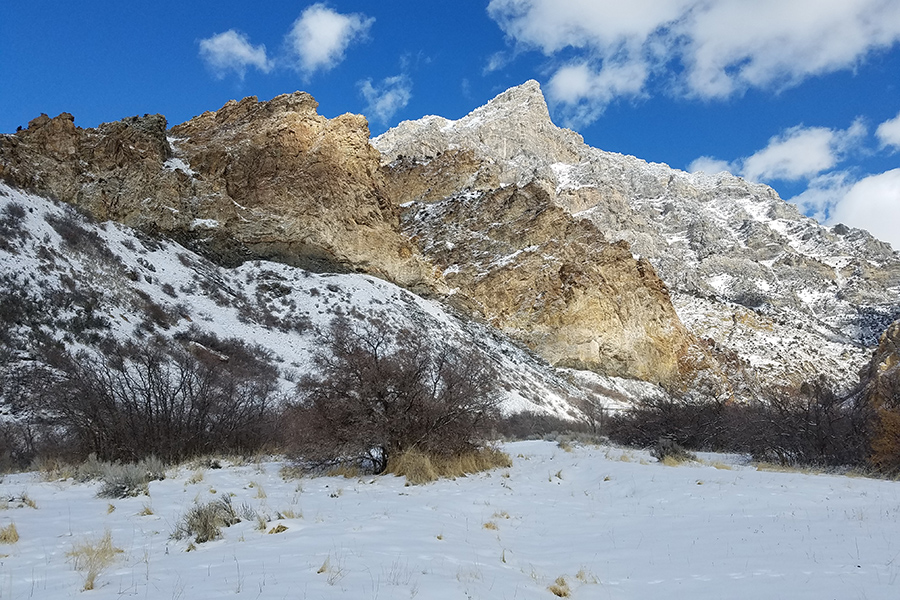
Stakeholder engagement and funding sources
To help stakeholders visualize how the ASR projects will work, Barr developed easy-to-understand graphics, maps, figures, and videos.
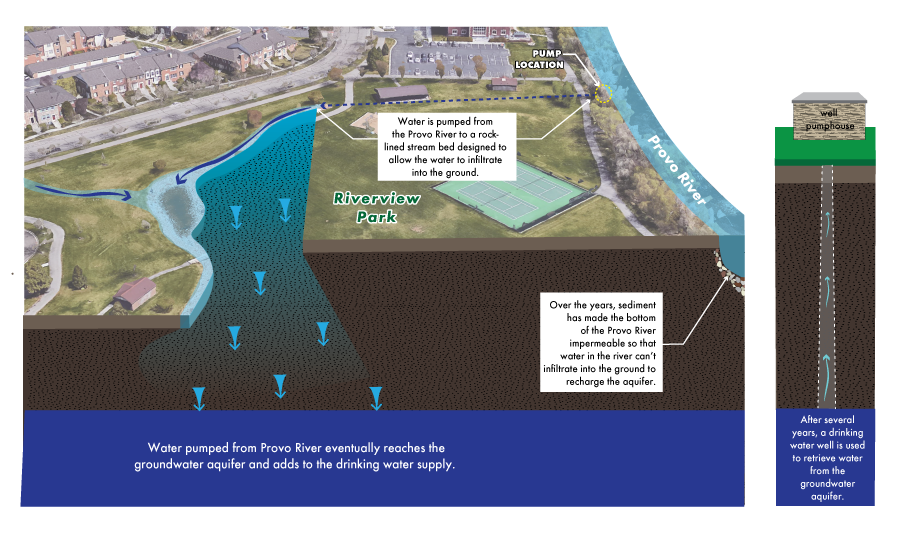
Multiple factors can impact the cost of an ASR project, including source water treatment requirements, siting considerations, target aquifer groundwater quality, recharge method, and new infrastructure needs. To help cover the costs, there are several state (programs vary) and federal grant and loan programs that can be leveraged.
Provo’s water source sustainability program includes construction of a new surface water treatment plant to reduce reliance only on groundwater and to treat surface water for use in infiltration and injection at identified ASR sites. The city’s drinking water system infrastructure will be used to transport water to one of the infiltration sites and the two injection well sites. Barr helped obtain over $80 million in state and federal grants and over $35 million in loan funds to help the city plan, permit, design, and construct the final ASR projects and the water treatment plant.
Future of ASR and water sustainability
An ASR project can serve as a valuable tool in tackling the challenges related to water supply. These projects help build long-lasting and resilient water systems to effectively address concerns with water availability, quality, and ecological sustainability. Beyond mitigating water shortages, MAR projects can also be implemented to serve as an effective barrier against contaminant plumes, prevent saltwater intrusion, and protect against ground subsidence caused by over pumping of groundwater.
For over half a century, Barr has helped clients monitor and improve water quality, understand, and protect groundwater and surface-water resources, and treat, store, and distribute the water their communities and facilities need, including ASR/MAR projects. Interested in exploring whether an ASR project can help you with your water demand challenges? Contact our team to learn more.
About the authors
Brian LeMon, vice president and senior civil engineer, has nearly four decades of experience with water supply, storage, treatment, and distribution; pumping system design; ASR/MAR; flood risk management; and wastewater collection and treatment. In addition, his areas of expertise include well planning and design; water-supply planning and system analysis; source-water protection planning; and water-system planning. He has served as principal, project manager, and/or engineer for planning, design, and rehabilitation of more than 100 water-supply wells. More than two million people drink water from systems for which Brian has provided engineering services.
John Greer, senior hydrogeologist, has nearly four decades of experience and has been involved in all aspects of geologic and hydrogeologic evaluations. John has expertise in aquifer testing; ASR/MAR; environmental site investigations; and groundwater modeling for regional contaminant-transport studies, remedial investigations and feasibility studies, evaluations of remedial systems design, wellhead protection, and water-supply assessments.
Related projects
Water supply sustainability study for City of Rochester
Rochester, Minnesota, is projected to experience population growth of over 40 percent by 2040. Currently, the city’s water supply is sourced entirely from groundwater with the majority coming from two aquifers. Rochester Public Utilities hired Barr to evaluate the long-term sustainability of the aquifers serving the city's drinking water system to help ensure that future water demand can be met in a sustainable manner. Barr conducted groundwater modeling to evaluate the potential impacts of proposed future pumping, field studies to fill data gaps, and an evaluation of potential new well sites. We also participated in regular meetings with state regulators and evaluated alternative water sources.
Groundwater-flow model of the Twin Cities metro area
For more than a decade, Barr has worked with the Metropolitan Council to develop, maintain, and update a groundwater-flow model of the eleven-county metropolitan area of Saint Paul and Minneapolis, Minnesota. The current version, Metro Model 3, is a major update to Metro Model 2, also developed by Barr. The model assists in evaluating groundwater use and water-sustainability issues, surface-water–groundwater interaction, short-term and long-term regional water planning, the effects of changing climate on groundwater, and groundwater appropriations.
PFAS-impacted drinking water response and treatment plant design
When the city of Bemidji, Minnesota, discovered per- and polyfluoroalkyl substances (PFAS) in its water supply, it turned to Barr to plan for and implement immediate and short-term response actions, as well as evaluate and test alternatives for a long-term solution. We designed and provided construction observation for a 2.2 million-gallon-per-day drinking water plant that successfully removes PFAS, iron, and manganese.
Groundwater monitoring for Fridley Filtration Plant rehabilitation
The City of Minneapolis Water Works (MWW) undertook a multiyear project to rehabilitate municipal water treatment infrastructure that serves more than 400,000 customers in the Minneapolis, Minnesota, area. Construction dewatering over a period of approximately 10 months was required to construct a large, underground concrete tank approximately 40 feet below the ground. The rehabilitation project is located adjacent to several Superfund sites with chlorinated volatile organic compound (VOC) groundwater impacts. Barr developed and implemented a groundwater monitoring program during the construction dewatering project to monitor the effects—if any—of the groundwater pumping on the chlorinated VOC-impacted groundwater from the adjacent contaminated sites.



